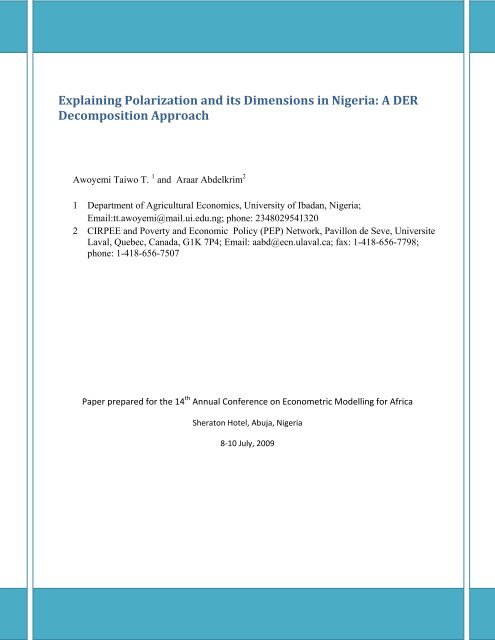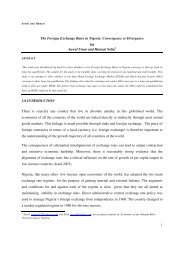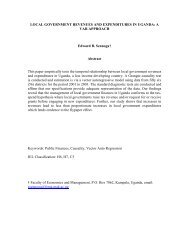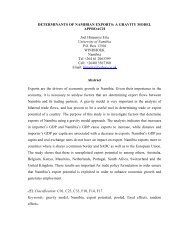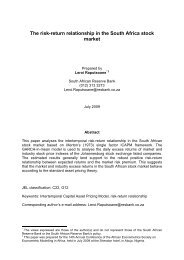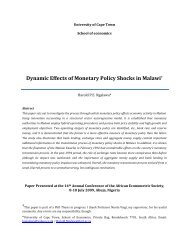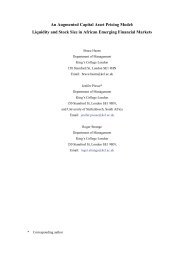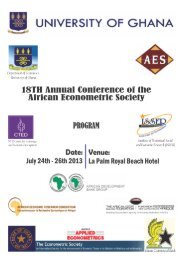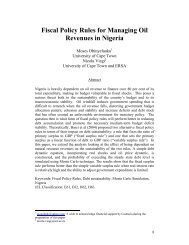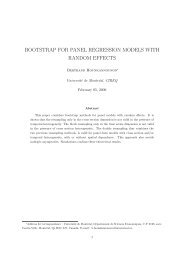Explaining Polarization and its Dimensions in Nigeria - African ...
Explaining Polarization and its Dimensions in Nigeria - African ...
Explaining Polarization and its Dimensions in Nigeria - African ...
You also want an ePaper? Increase the reach of your titles
YUMPU automatically turns print PDFs into web optimized ePapers that Google loves.
<strong>Expla<strong>in</strong><strong>in</strong>g</strong> <strong>Polarization</strong> <strong>and</strong> <strong>its</strong> <strong>Dimensions</strong> <strong>in</strong> <strong>Nigeria</strong>: A DER<br />
Decomposition Approach<br />
Awoyemi Taiwo T. 1 <strong>and</strong> Araar Abdelkrim 2<br />
1 Department of Agricultural Economics, University of Ibadan, <strong>Nigeria</strong>;<br />
Email:tt.awoyemi@mail.ui.edu.ng; phone: 2348029541320<br />
2 CIRPEE <strong>and</strong> Poverty <strong>and</strong> Economic Policy (PEP) Network, Pavillon de Seve, Universite<br />
Laval, Quebec, Canada, G1K 7P4; Email: aabd@ecn.ulaval.ca; fax: 1-418-656-7798;<br />
phone: 1-418-656-7507<br />
Paper prepared for the 14 th Annual Conference on Econometric Modell<strong>in</strong>g for Africa<br />
Sheraton Hotel, Abuja, <strong>Nigeria</strong><br />
8‐10 July, 2009
<strong>Expla<strong>in</strong><strong>in</strong>g</strong> <strong>Polarization</strong> <strong>and</strong> <strong>its</strong> <strong>Dimensions</strong> <strong>in</strong> <strong>Nigeria</strong>: A DER<br />
Decomposition Approach<br />
Awoyemi Taiwo T. 1 <strong>and</strong> Araar Abdelkrim 2<br />
1. Department of Agricultural Economics, University of Ibadan, <strong>Nigeria</strong>;<br />
Email:tt.awoyemi@mail.ui.edu.ng; phone: 2348029541320<br />
2. CIRPEE <strong>and</strong> Poverty <strong>and</strong> Economic Policy (PEP) Network, Pavillon de Seve,<br />
Universite Laval, Quebec, Canada, G1K 7P4; Email: aabd@ecn.ulaval.ca; fax: 1-418-<br />
656-7798; phone: 1-418-656-7507<br />
Abstract<br />
<strong>Nigeria</strong> is a country of high ethnic <strong>and</strong> l<strong>in</strong>guistic diversity, threatened by <strong>in</strong>ternal fissures <strong>and</strong><br />
persistent levels of violence. It is argued that, ethnically polarized societies are prone to<br />
competitive rent-seek<strong>in</strong>g activities by different groups <strong>and</strong> will have difficulty agree<strong>in</strong>g on public<br />
goods such as <strong>in</strong>frastructure, education, <strong>and</strong> good policies. This <strong>in</strong> part expla<strong>in</strong>s high level of<br />
<strong>in</strong>equity <strong>in</strong> <strong>in</strong>come distribution <strong>and</strong> poverty <strong>in</strong> the country. High potential for large regional<br />
differences <strong>in</strong> economic <strong>and</strong> social conditions makes <strong>Nigeria</strong> susceptible to dis<strong>in</strong>tegration if the<br />
regional differences <strong>in</strong> st<strong>and</strong>ards of liv<strong>in</strong>g cont<strong>in</strong>ue to grow. Thus, the study aims to give <strong>in</strong>sight<br />
<strong>in</strong>to the extent to which <strong>in</strong>come <strong>in</strong>equality has been socially embedded (polarization) <strong>in</strong> <strong>Nigeria</strong>,<br />
when the rich <strong>and</strong> the poor are dist<strong>in</strong>guished not only by their wealth, but also by their language,<br />
ethnicity, or other social characteristic <strong>and</strong> account for the factors responsible. Data used for the<br />
study were from the 2003/2004 National Liv<strong>in</strong>g St<strong>and</strong>ard Survey data set collected by <strong>Nigeria</strong><br />
National Bureau of Statistics. Duclos, Esteban <strong>and</strong> Ray (2004) (DER) method which is based on<br />
identification (the degree of equality with<strong>in</strong> each group) - alienation (the degree of <strong>in</strong>come<br />
differences among groups) framework, derived from rigorous axioms, avoid<strong>in</strong>g arbitrary choices<br />
of <strong>in</strong>come ranges <strong>and</strong> let the area of identification <strong>in</strong>fluence be determ<strong>in</strong>ed by nonparametric<br />
kernel techniques, was decomposed. The results reveal a polarization measure of 0.25 ( α = 0.5)<br />
with 0.41, 0.74 alienation <strong>and</strong> identification components respectively. High level of<br />
identification component suggests emerg<strong>in</strong>g level of bi-polarization <strong>in</strong> <strong>Nigeria</strong>. Variations<br />
between the zones (0.83) expla<strong>in</strong> polarization more than <strong>in</strong>tra-zonal variation (0.17). Urban<br />
sector (0.25) is slightly more polarized than rural sector (0.24). The population of secondary<br />
school leavers, unemployed <strong>and</strong> retirees, has become significant enough to expla<strong>in</strong> part of<br />
polarization <strong>in</strong> the country (0.15 <strong>and</strong> 0.35 respectively). Thus, employment creat<strong>in</strong>g <strong>in</strong>itiatives<br />
<strong>and</strong> effective social policies will go a long way <strong>in</strong> alleviat<strong>in</strong>g polarization <strong>in</strong> the country.<br />
Equitable distribution of <strong>in</strong>come <strong>and</strong> poverty reduc<strong>in</strong>g policies will also reduce other negative<br />
aspects of polarization like severe poverty <strong>and</strong> higher level of between group <strong>in</strong>equalities.<br />
Key words: Inequality, polarization decomposition, dimensions, violence <strong>and</strong> poverty reduction<br />
JEL: D63, D64<br />
This work was carried out with fund<strong>in</strong>g from the Poverty <strong>and</strong> Economic Policy (PEP) Research Network<br />
which is f<strong>in</strong>anced by the Australian Agency for International Development (AusAID) the Canadian<br />
International Development Agency <strong>and</strong> the International Development Research Centre (IDRC).<br />
2
1.0 Introduction<br />
<strong>Nigeria</strong> is a populous country with a large territory which covers many climatic regions, several<br />
ethnic groups <strong>and</strong> different religious groups. It is not surpris<strong>in</strong>g to f<strong>in</strong>d large regional differences<br />
<strong>in</strong> <strong>its</strong> economic <strong>and</strong> social conditions. Although, there are about 374 identifiable ethnic groups,<br />
the country’s <strong>in</strong>dependent history has been marked by the rivalry between the “big three” ethnoregional<br />
clusters that, comb<strong>in</strong>ed, represent roughly 72.7 per cent of the population: the Hausa-<br />
Fulani <strong>in</strong> the north (39.1 per cent), the Igbo <strong>in</strong> the south east (11.7 per cent) <strong>and</strong> the Yoruba <strong>in</strong><br />
the south west (21.4 per cent). Their rivalry runs through post-<strong>in</strong>dependence history. Politicized<br />
tribal feel<strong>in</strong>gs have provoked not only a civil war <strong>in</strong> 1970 but also fear among many <strong>Nigeria</strong>ns<br />
that one of the three may come to dom<strong>in</strong>ate the whole. There is widespread notion that the<br />
lopsided distribution of the resources of the nation accounted for strong agitation to control<br />
power, <strong>and</strong> therefore resources at the centre. More than anyth<strong>in</strong>g else, ethnicity has fostered a<br />
political culture where the struggle for <strong>in</strong>ter-ethnic equity has impeded that for democratic rights<br />
– both of the <strong>in</strong>dividual <strong>and</strong> the group. It has been observed that, ethnically polarized societies<br />
are prone to competitive rent-seek<strong>in</strong>g activities by different groups <strong>and</strong> will have difficulty<br />
agree<strong>in</strong>g on public goods such as <strong>in</strong>frastructure, education, <strong>and</strong> good policies (Ales<strong>in</strong>a <strong>and</strong><br />
Tabell<strong>in</strong>i 1989; Ales<strong>in</strong>a <strong>and</strong> Drazen, 1991). This may <strong>in</strong> part expla<strong>in</strong> why <strong>Nigeria</strong> has produced<br />
more than $400 billion <strong>in</strong> oil revenue s<strong>in</strong>ce the early 1970s, (International Crisis Group, 2006)<br />
but an average <strong>Nigeria</strong>n is poorer today than four decades ago. This persistent high level of<br />
poverty <strong>and</strong> <strong>in</strong>equity <strong>in</strong> <strong>in</strong>come distribution <strong>in</strong> <strong>Nigeria</strong> has been so far well documented,<br />
(Canagarajah, et al., 1997; Aighokhan, 2000; Araar <strong>and</strong> Awoyemi, 2006; NBS, 2006; Awoyemi<br />
et.al 2009). Additionally, there is also a large differential <strong>in</strong> wellbe<strong>in</strong>g across the zones <strong>and</strong><br />
ethnic groups <strong>in</strong> the country. High potential for large regional differences <strong>in</strong> economic <strong>and</strong> social<br />
3
conditions makes the country susceptible to dis<strong>in</strong>tegration if the regional differences <strong>in</strong> st<strong>and</strong>ards<br />
of liv<strong>in</strong>g cont<strong>in</strong>ue to grow. This could become a more <strong>in</strong>tense political issue when spatial<br />
<strong>in</strong>equality is perceived to be related to discrim<strong>in</strong>ation aga<strong>in</strong>st particular groups of citizens such as<br />
rural farmers (compared to urban residents), ethnic m<strong>in</strong>orities concentrated <strong>in</strong> remote areas,<br />
migrants <strong>in</strong> certa<strong>in</strong> districts, or religious groups <strong>in</strong> particular regions (Shorrocks <strong>and</strong> Wan 2004).<br />
This evidence underscores the need to go beyond conventional measures of <strong>in</strong>equality if concern<br />
is about political feasibility <strong>and</strong> cont<strong>in</strong>uity of reform policies as currently <strong>in</strong>itiated <strong>in</strong> <strong>Nigeria</strong>.<br />
So, the search light has been focused on the extent to which <strong>in</strong>come <strong>in</strong>equality has been socially<br />
embedded <strong>in</strong> <strong>Nigeria</strong>. Economic <strong>in</strong>equality can be said to be socially embedded when the rich<br />
<strong>and</strong> the poor are dist<strong>in</strong>guished not only by their wealth, but also by their language, ethnicity, race<br />
or other social characteristic (Zhang <strong>and</strong> Kanbur, 2001). The conjecture that motivates research<br />
on this phenomenon of polarization is that contrasts among homogeneous groups can cause<br />
social tension. One of the earliest works on polarization <strong>in</strong> <strong>Nigeria</strong> was done by Aighokhan,<br />
(2000) who showed concern <strong>and</strong> alerted the country on the danger of disappear<strong>in</strong>g middle class.<br />
He remarked that any government <strong>in</strong>terested <strong>in</strong> cont<strong>in</strong>uity <strong>and</strong> the susta<strong>in</strong>ability of <strong>its</strong> policies<br />
must show serious concern to what is happen<strong>in</strong>g to the middle <strong>in</strong>come group. Of recent,<br />
Awoyemi et al., (2009) reported the case of emerg<strong>in</strong>g <strong>and</strong> <strong>in</strong>creas<strong>in</strong>g level of bi-polarization<br />
result<strong>in</strong>g from persistent <strong>in</strong>crease <strong>in</strong> identification component of polarization <strong>and</strong> the grow<strong>in</strong>g<br />
proportion of <strong>Nigeria</strong>n poor at the bottom of the country <strong>in</strong>come distribution. This phenomenon<br />
is emerg<strong>in</strong>g <strong>in</strong> <strong>Nigeria</strong> as a result of some observed specific characteristics of different groups.<br />
This paper aims to give <strong>in</strong>sight <strong>in</strong>to the key underly<strong>in</strong>g factors fuel<strong>in</strong>g the sense of diversity that<br />
may lead to social tension <strong>and</strong> conflicts <strong>in</strong> <strong>Nigeria</strong>. Toward this, we analyze the <strong>in</strong>fluence of<br />
4
socio-economic, demographic <strong>and</strong> occupational group variables <strong>in</strong> expla<strong>in</strong><strong>in</strong>g the level of<br />
polarization <strong>in</strong> <strong>Nigeria</strong>.<br />
The rest of the paper is organized as follows. Section two presents rationale for the study while<br />
section 3 discusses the source <strong>and</strong> types of data used. Section 4 considers related literatures<br />
followed by section 5 which deals with the model <strong>and</strong> method of <strong>its</strong> estimation. Section 6<br />
presents <strong>and</strong> discusses the results while section 7 concludes.<br />
2.0 Rationale for the study<br />
This study underwrites <strong>its</strong> policy relevance <strong>in</strong> develop<strong>in</strong>g economy of <strong>Nigeria</strong> <strong>in</strong> which<br />
economic status <strong>and</strong> social categories like ethnic groups <strong>and</strong> religion are strongly correlated <strong>and</strong><br />
which can be described as polarized along these dimensions. First, <strong>in</strong> order to implement<br />
appropriate <strong>in</strong>stitutional sett<strong>in</strong>gs <strong>and</strong> policies that will reduce the feel<strong>in</strong>g of grievance; the policy<br />
makers must underst<strong>and</strong> the nature of the underly<strong>in</strong>g factors fuel<strong>in</strong>g sense of diversity. This<br />
paper gives <strong>in</strong>sight <strong>in</strong>to this <strong>and</strong> provides <strong>in</strong>formation that could guide the formulation of a more<br />
egalitarian <strong>and</strong> peaceful society as well as policies aimed at help<strong>in</strong>g lagg<strong>in</strong>g regions. This will <strong>in</strong><br />
particular <strong>in</strong>fluence the distribution of <strong>in</strong>frastructural facilities <strong>in</strong> the country. Second, given<br />
<strong>in</strong>equality, polarization measurements can be used to judge tax reform policy (Rodríguez et al.,<br />
2005). Brilliant efforts are currently been made on tax reform <strong>in</strong> <strong>Nigeria</strong>. Results from studies<br />
like this would give <strong>in</strong>sight <strong>in</strong>to the groups which bear the burden or benef<strong>its</strong> of government<br />
spend<strong>in</strong>g or tax regime. These will <strong>in</strong>-turn <strong>in</strong>form our policy makers on tax regime to adopt -<br />
progressive or regressive tax option thus, guide future deliberations on tax issues <strong>in</strong> <strong>Nigeria</strong>.<br />
Thus, the paper is set to analyze how characteristics other than <strong>in</strong>come expla<strong>in</strong> the level of<br />
polarization <strong>in</strong> <strong>Nigeria</strong>.<br />
5
3.0. Data <strong>and</strong> household surveys<br />
Data used for this study were sourced from the 2004 World Bank assisted National Liv<strong>in</strong>g<br />
St<strong>and</strong>ard Survey (NLSS) collected by the National Bureau of Statistics (NBS). This survey was<br />
designed to provide estimate at both state <strong>and</strong> local government levels. A two-stage stratified<br />
sampl<strong>in</strong>g method was adopted. At the first stage, from each of the 36 states <strong>and</strong> the Federal<br />
Capital Territory (FCT, Abuja), cluster of 120 hous<strong>in</strong>g un<strong>its</strong> called Enumeration area (EA) were<br />
r<strong>and</strong>omly selected. The second stage <strong>in</strong>volved r<strong>and</strong>om selection of 5 hous<strong>in</strong>g un<strong>its</strong> from the<br />
selected EAs. A total of 600 households were r<strong>and</strong>omly chosen <strong>in</strong> each state <strong>and</strong> the FCT,<br />
summ<strong>in</strong>g up to 22,200 households <strong>in</strong> all (NBS, 2003). Prelim<strong>in</strong>ary analysis of the data shows<br />
that out of the 22,200 households that were targeted, only, 19158 completed the questionnaire.<br />
The NLSS consists of an <strong>in</strong>tegrated household questionnaire designed to collect data on multiple<br />
aspects of household welfare. This NLSS questionnaire among others covers the follow<strong>in</strong>g<br />
topics: household size; household consumption level; hous<strong>in</strong>g; education; employment <strong>and</strong> wage<br />
<strong>in</strong>come; health; agriculture; transfers <strong>and</strong> other non- labor <strong>in</strong>come. This is to say that the data set<br />
is sufficiently rich for this study. We choose consumption as our <strong>in</strong>dicator of well-be<strong>in</strong>g. Total<br />
consumption is estimated from the total household expenditure, other expenditure, money paid to<br />
the government, <strong>and</strong> other money spent. The approach of us<strong>in</strong>g per capita expenditure has been<br />
used <strong>in</strong> many studies on poverty <strong>in</strong> <strong>Nigeria</strong> (e.g. Canagarajah <strong>and</strong> Thomas, 2001). The study<br />
relies on the analysis of the national data based primarily on the six geo-political zones of the<br />
country. These zones consist of South-South, South-East, South-West, North-Central, North-<br />
East, <strong>and</strong> North-West which are well def<strong>in</strong>ed politically, territorially <strong>and</strong> culturally. These zones<br />
6
cut across different geographical belts start<strong>in</strong>g from the forest belt <strong>in</strong> the south to the derived<br />
savannah <strong>in</strong> the north. The country has great potential for regional disparity.<br />
4.0 Literature Review<br />
In recent years there has been an upsurge of <strong>in</strong>terest on <strong>in</strong>come polarization as a different<br />
concept from <strong>in</strong>equality (Wolfson, 1997, Esteban <strong>and</strong> Ray, 1994, Duclos, Esteban <strong>and</strong> Ray 2004,<br />
Rodríguez <strong>and</strong> Salas 2004, Araar, 2008, Awoyemi, et al. 2009). Theoretically, <strong>in</strong>equality relates<br />
to the overall dispersion of the distribution, polarization concentrates on <strong>in</strong>come distribution <strong>in</strong><br />
several focal or polar modes (Juan et al, 2001 Rodreque <strong>and</strong> Salas, 2005). Accord<strong>in</strong>g to Wolfson<br />
(1994), a bipolarized <strong>in</strong>come distribution is one that is spread out from the median <strong>in</strong>come value,<br />
so there are fewer <strong>in</strong>dividuals or families with middle level <strong>in</strong>comes. In a different way, Esteban<br />
<strong>and</strong> Ray (1994) adopt an identification-alienation framework. Identification relates to the notion<br />
of a with<strong>in</strong>-groups feel<strong>in</strong>g of identity. Meanwhile, alienation relates to the <strong>in</strong>come distance<br />
between people <strong>in</strong> different groups. Besides, Esteban et al. (1999) suggest divid<strong>in</strong>g the<br />
population by the mean value, <strong>in</strong>stead of the median value used by Wolfson (1994). Although,<br />
the issue of polarization is ga<strong>in</strong><strong>in</strong>g prom<strong>in</strong>ence <strong>in</strong> recent discussions on <strong>in</strong>come distribution,<br />
there is little or no <strong>in</strong>formation on this phenomenon <strong>in</strong> <strong>Nigeria</strong>. One of the earliest works was<br />
done by Aighokhan, (2000) who showed concern <strong>and</strong> alerted the country on the danger of<br />
disappear<strong>in</strong>g middle class <strong>in</strong> <strong>Nigeria</strong>. He remarked that any government <strong>in</strong>terested <strong>in</strong> cont<strong>in</strong>uity<br />
<strong>and</strong> the susta<strong>in</strong>ability of <strong>its</strong> policies must show serious concern to what is happen<strong>in</strong>g to the<br />
middle <strong>in</strong>come group.<br />
In spite of the aforementioned reasons, studies on regional polarization are almost of no<br />
existence <strong>in</strong> <strong>Nigeria</strong>. For <strong>in</strong>stance, Alay<strong>and</strong>e (2003), Aighokhan, (2000), Okunmadewa et al.<br />
(2006) Awoyemi <strong>and</strong> Adeoti, (2004), <strong>in</strong> all these studies, regional polarization is either not<br />
7
mentioned or touched <strong>in</strong> pass<strong>in</strong>g. To the best knowledge of the authors, study on regional<br />
polarization is <strong>in</strong> <strong>its</strong> very <strong>in</strong>fancy. This study attempts to fill the gaps identified above <strong>and</strong><br />
extends the methods earlier used by rely<strong>in</strong>g on the recently developed methods to assess the<br />
issue of disappear<strong>in</strong>g middle class, at the national, zonal <strong>and</strong> sectoral levels <strong>in</strong> <strong>Nigeria</strong>.<br />
5.0 Models <strong>and</strong> method of estimation<br />
Duclos, Esteban <strong>and</strong> Ray (DER) (2004) <strong>in</strong>dex<br />
On the dimensions of polarization, we assume that groups are determ<strong>in</strong>ed by characteristics<br />
which their members share, not only on <strong>in</strong>come, but also on the basis of other relevant attributes,<br />
as it is possible that there exists a high correlation between <strong>in</strong>come <strong>and</strong> other characteristics. The<br />
ma<strong>in</strong> aim here is to present how these characteristics expla<strong>in</strong> polarization <strong>in</strong> <strong>Nigeria</strong>.<br />
Duclos, Esteban <strong>and</strong> Ray (2004) method allows for <strong>in</strong>dividuals not to be clustered around<br />
discrete <strong>in</strong>come <strong>in</strong>tervals, <strong>and</strong> lets the area of identification <strong>in</strong>fluence be determ<strong>in</strong>ed by<br />
nonparametric kernel techniques, avoid<strong>in</strong>g arbitrary choices of <strong>in</strong>come ranges. The authors<br />
establish that a general polarization measure that respects a basic set of axioms must be<br />
proportional to:<br />
α<br />
Pα ( F) =∫ f ( y) g( y) dF( y)<br />
(1)<br />
where y denotes <strong>in</strong>come <strong>and</strong> F(y) <strong>its</strong> distribution. The function g(y) captures the alienation effect<br />
while f ( y)<br />
α captures the identification effect. The higher the α parameter, the larger the weight<br />
attached to identification <strong>in</strong> the polarization <strong>in</strong>dex. The value of α should be set by the analyst,<br />
the policy maker or <strong>in</strong> general the person who is evaluat<strong>in</strong>g <strong>in</strong>come polarization <strong>in</strong> a given<br />
economy. In that sense α implicitly captures the value judgments of the analyst. DER follow<br />
rigorous axiomatic development of the polarization concept <strong>and</strong> estimation <strong>in</strong> the “density case”.<br />
The authors start off with f as such a density; they are <strong>in</strong>terested <strong>in</strong> <strong>its</strong> polarization P(f).<br />
8
Follow<strong>in</strong>g the notion of “alienation” (A) <strong>and</strong> “identification”(I) first, <strong>in</strong> a unidimentional<br />
polarization (G = 1), <strong>in</strong> this case pure <strong>in</strong>come polarization for each <strong>in</strong>dividual with <strong>in</strong>come<br />
located <strong>in</strong> the support of f. They presume that an <strong>in</strong>dividual located at x, feels alienation vis-a-vis<br />
another located at y, <strong>and</strong> that this alienation is monotonic <strong>in</strong> distance |x − y|. It is also, presumed<br />
that an <strong>in</strong>dividual located at <strong>in</strong>come x experiences a sense of identification that depends on the<br />
density at x, f(x). (Note, G denotes the number of groups, x denotes the level of <strong>in</strong>come x <strong>and</strong> y<br />
denotes the level of <strong>in</strong>come y). This method is of <strong>in</strong>terest as a characterized measure of<br />
polarization not only because it is a natural extension of the work of ER but also appropriate for<br />
the case of cont<strong>in</strong>uous distributions of our <strong>in</strong>come variable. The follow<strong>in</strong>g axioms that are<br />
satisfied by the DER <strong>in</strong>dex are based on a density with f<strong>in</strong>ite support (kernel), <strong>and</strong> symmetric<br />
reductions <strong>in</strong> dispersion that concentrate the density around <strong>its</strong> mean (squeezes).<br />
Axiom 1: if a distribution is made up of a basic density, then a squeeze cannot <strong>in</strong>crease<br />
polarization. A s<strong>in</strong>gle squeeze, <strong>in</strong> an environment where there is just one basic component,<br />
cannot <strong>in</strong>crease polarization (Duclos et al. 2004). In other words, if a distribution made up of a<br />
population that can be scaled or undergo a slide (basic density) is collapsed <strong>in</strong>wards towards <strong>its</strong><br />
global mean (squeeze), polarization will not <strong>in</strong>crease.<br />
Axiom2: if a symmetric distribution is composed of three basic densities then a squeeze <strong>in</strong> the<br />
outer densities should not reduce polarization. Here, as opposed to axiom 1, the squeeze is local<br />
<strong>and</strong> not global <strong>and</strong> will not decrease polarization, although <strong>in</strong>ternal alienations <strong>in</strong> each<br />
component densities decreases, as contrast to <strong>in</strong>equality measures.<br />
Axiom 3: if we consider a symmetric distribution made up of four basic densities with disjo<strong>in</strong>t<br />
supports, then a move of the center distributions towards their outer neighbors, while keep<strong>in</strong>g<br />
9
the disjo<strong>in</strong>t supports, should <strong>in</strong>crease polarization. This is to say that a symmetric outward slide<br />
will <strong>in</strong>crease polarization.<br />
Axiom 4: Given two distributions F <strong>and</strong> G, if P(F)≥P(G), P(G), be<strong>in</strong>g P(F) <strong>and</strong> P(G) the<br />
respective polarization <strong>in</strong>dexes, it must be that P(αF)≥P(αG) where αF <strong>and</strong> αG represent a<br />
rescaled version of F <strong>and</strong> G. This states that if one situation exhib<strong>its</strong> greater polarization than<br />
another, it must cont<strong>in</strong>ue to do so when populations <strong>in</strong> both situations are scaled up or down by<br />
the same amount, leav<strong>in</strong>g all (relative) distributions unchanged (Duclos et al. 2004).<br />
Estimation method<br />
As <strong>in</strong> ER, effective antagonism of an <strong>in</strong>dividual with <strong>in</strong>come x towards another person of <strong>in</strong>come<br />
y (under f ) could be written as T(i,a) where i = f(x) <strong>and</strong> a = |x − y|. It is assumed that T is<br />
<strong>in</strong>creas<strong>in</strong>g <strong>in</strong> <strong>its</strong> second argument <strong>and</strong> that T(i,0) = t(0,a) = 0, just as <strong>in</strong> ER. Here, polarization is<br />
proportional to the “sum” of all effective antagonisms written as:<br />
PF ( ) = ∫∫ T( f ( x), x−<br />
y) f( x) f( y)<br />
dxdy<br />
(2)<br />
DER establish that a general polarization measure P, as described <strong>in</strong> (6), satisfies axiom 1-4 of<br />
polarization if <strong>and</strong> only if it is proportional to<br />
1+<br />
α<br />
Pα<br />
( f ) ≡∫∫ f ( x) f ( y) y −x dydx,<br />
(3)<br />
whereα<br />
[.25,1]<br />
Concerns about estimat<strong>in</strong>g procedure <strong>and</strong> associated statistical <strong>in</strong>ference follow DER approach<br />
which first remark that for every distribution function F with associated density f <strong>and</strong> mean µ,<br />
we have P ( F) f( y) α<br />
α<br />
=∫ a( y) dF( y)<br />
, (4)<br />
10
with μ ( )<br />
y<br />
ay ( ) ≡ + y2 Fy ( ) −1 −2 ∫ xdFx ( ). From our r<strong>and</strong>om sample size n assumed to be from<br />
−∞<br />
i.i.d observations of expenditure yi, i=1, …, n, drawn from the distribution F(y) <strong>and</strong> ordered such<br />
that y i ≤ y 2 ≤ …≤ y n . Pα(F) was estimated as:<br />
P F ) = n∑ f )<br />
y a ) y<br />
n<br />
−1<br />
α<br />
α<br />
( ) (<br />
i) (<br />
i)<br />
i=<br />
1<br />
, (5)<br />
)<br />
where a( y i<br />
)<br />
is given as<br />
i−1<br />
) )<br />
⎛ ⎞<br />
−1 −1<br />
a( yi) = μ + yi( n (2i−1) −1) − n ⎜2∑<br />
yj + yi⎟<br />
⎝ j=<br />
1 ⎠<br />
) )<br />
μ is the sample mean, <strong>and</strong> where f ( y i<br />
)<br />
α is estimated nonparametrically us<strong>in</strong>g kernel estimation<br />
procedures. It smoothes the density avoid<strong>in</strong>g the noise <strong>in</strong>duced by the use of a sample <strong>in</strong>stead of<br />
the whole population. We estimated a function f ( y) over the logarithm of <strong>in</strong>comes y=(y1, ..., yn)<br />
<strong>in</strong> the sample assum<strong>in</strong>g that there exists an orig<strong>in</strong>al density f(y) from which the sample was<br />
extracted. We used the estimator:<br />
(6)<br />
n<br />
1 ⎛ yj<br />
− yi<br />
⎞<br />
fˆ( yi<br />
) = ∑ K⎜<br />
⎟∀j<br />
hy ( ) i=<br />
1 ⎝ h<br />
(7)<br />
⎠<br />
where h(.) smooth<strong>in</strong>g b<strong>and</strong>with parameters, <strong>and</strong> K(.) is the kernel function, which is Gaussian <strong>in</strong><br />
our case. These estimates were computed us<strong>in</strong>g the facilities <strong>in</strong> the DAD software developed by<br />
Araar, Duclos <strong>and</strong> Fort<strong>in</strong>, (2006).<br />
5.1 The socio-demographic sub-population groups <strong>and</strong> polarization: DER decomposition<br />
method<br />
The ma<strong>in</strong> aim here is to account for the contributions of socio-demographic characteristics or<br />
how some population groups can expla<strong>in</strong> the level of polarization <strong>in</strong> <strong>Nigeria</strong>. First, we are guided<br />
by the pioneer work of Bhattacharaya <strong>and</strong> Mahalanobis (1967) on the decomposition of G<strong>in</strong>i<br />
11
<strong>in</strong>dex, <strong>and</strong> largely the work of Pyatt, (1976), Lambert <strong>and</strong> Aronso, (1993) <strong>and</strong> Araar (2006) on<br />
the decomposition of <strong>in</strong>equality <strong>in</strong>dex by sub-population groups. The idea is that between-group<br />
<strong>in</strong>equality represents the <strong>in</strong>equality of the group when each household has the average <strong>in</strong>come of<br />
<strong>its</strong> group. Then the algebraic decomposition of the G<strong>in</strong>i <strong>in</strong>dex takes the follow<strong>in</strong>g form:<br />
w<br />
A = ∑ϕ<br />
g<br />
ψ<br />
g<br />
Ag<br />
+ A + R<br />
g<br />
Where<br />
ϕ<br />
g<br />
<strong>and</strong><br />
ψ<br />
g<br />
are the population <strong>and</strong> <strong>in</strong>come shares of the group g respectively. A w is the<br />
between group <strong>in</strong>equality <strong>and</strong> equals to the G<strong>in</strong>i <strong>in</strong>dex when each member of the group has the<br />
average <strong>in</strong>come of <strong>its</strong> group. It is good to note that if <strong>in</strong>comes do not overlap, the residual part<br />
(R) of this decomposition vanishes (Araar, 2008). It follows that group with low residual of<br />
relative contribution will have high explanatory power of the polarization. This decomposition of<br />
G<strong>in</strong>i <strong>in</strong>dex helps to shed light on the decomposition of polarization as we can use the <strong>in</strong>dicator<br />
R/A to assess the explanatory power of the <strong>in</strong>terest group to polarization. This we applied to the<br />
decomposition of the DER <strong>in</strong>dex by population groups follow<strong>in</strong>g Araar (2008). Here our groups<br />
comprise of zone, sector, educational groups, occupational groups <strong>and</strong> sex.<br />
From (2), DER could <strong>in</strong> a way be written as:<br />
[ ]<br />
P= AI( α) 1+ ρ<br />
(9)<br />
(8)<br />
where<br />
1+<br />
α<br />
I( α ) f( y)<br />
dy<br />
= ∫ is the average identification component, A the G<strong>in</strong>i coefficient <strong>and</strong> the<br />
parameter ρ is the normalized covariance between alienation <strong>and</strong> identification which is equals<br />
to<br />
x<br />
α<br />
( [ ])( ⎡ ⎤)<br />
∫ ax ( ) = Ea f( x) −E ⎣<br />
f ⎦<br />
f( xdx )<br />
ρ = (10)<br />
AI<br />
12
ax ( ) is the alienation component which can be decomposed <strong>in</strong>to δ ( x)<br />
<strong>and</strong> σ ( x)<br />
, the expected<br />
deprivation <strong>and</strong> surplus of <strong>in</strong>dividual with <strong>in</strong>come x respectively<br />
ax ( ) = δ ( x) + σ ( x)<br />
Accord<strong>in</strong>g to Runciman (1966), the magnitude of relative deprivation is the difference between<br />
the desired situation <strong>and</strong> the actual situation of a person.<br />
Replac<strong>in</strong>g ax ( ) = δ ( x) + σ ( x)<br />
<strong>in</strong> equation (3) we f<strong>in</strong>d that<br />
∫ f x x x dx = D+S (11)<br />
1<br />
P= ( ) +α [ δ ( ) + σ ( )]<br />
1<br />
where D= ∫ ( ) +α [ δ ( ) + σ ( )]<br />
f x x x dxis the deprivation component <strong>and</strong> the complement part S is<br />
the surplus. When the distribution is symmetric or when the parameter α equals zero, these two<br />
components are equal. Given the usual asymmetric distribution of <strong>in</strong>comes, expectedly<br />
D<br />
> S (Araar, 2008).<br />
∫ f x x x dx <strong>and</strong> let the density function for group g be f g<br />
the<br />
1<br />
Follow<strong>in</strong>g ( ) +α [ δ ( ) + σ ( )]<br />
contribution of <strong>in</strong>dividual(s) with <strong>in</strong>come x to the DER <strong>in</strong>dex is written as:<br />
1+<br />
α<br />
ax ( ) f( x)<br />
cx ( ) = . (12)<br />
1−α<br />
μ<br />
6.0 Results <strong>and</strong> Discussions<br />
6.1 <strong>Polarization</strong><br />
It is shown that polarization measures provide <strong>in</strong>formation that <strong>in</strong>equality measures do not,<br />
add<strong>in</strong>g important <strong>in</strong>sights for the analysis of sectoral <strong>and</strong> zonal <strong>in</strong>come dynamics. Table 1 shows<br />
results of the decomposition of polarization us<strong>in</strong>g DER identification-alienation frame work. It is<br />
evident that identification component (0.74) is higher than alienation component (0.41),<br />
reflect<strong>in</strong>g the significant size of the groups. It is strik<strong>in</strong>g that urban sector is slightly more<br />
polarized than the rural sector, despite the fact that rural sector habours larger portion of the<br />
13
population than the urban sector. Perhaps, higher degree of alienation (0.42) <strong>in</strong> the urban sector<br />
as a result of higher degree of <strong>in</strong>ter group disparities compare with lower degree of <strong>in</strong>ter-group<br />
disparities <strong>in</strong> the rural sector <strong>and</strong> lower degree of alienation (0.39) makes this expla<strong>in</strong>able.<br />
Northern zones seem to be more polarized than the southern zones. This may be as a result of<br />
high level of similarities <strong>in</strong> attributes with<strong>in</strong> the zones, <strong>and</strong> positive feel<strong>in</strong>gs toward the groups as<br />
reflected by high degree of identification. It is worth not<strong>in</strong>g that these could signal emerg<strong>in</strong>g<br />
level of bipolarization <strong>and</strong> <strong>in</strong>herent potential of social tension <strong>and</strong> conflicts <strong>in</strong> the country<br />
Table 1: Duclos, Esteban <strong>and</strong> Ray (DER) analysis of polarization (2004) (alpha=0.5)<br />
Subgroups Estimate Alienation Identification<br />
Sector<br />
Rural 0.24 0.39 0.74<br />
Urban 0.25 0.42 0.74<br />
Geopolitical zones<br />
South South 0.24 0.39 0.75<br />
South East 0.23 0.37 0.75<br />
South West 0.24 0.40 0.73<br />
North Central 0.25 0.42 0.78<br />
North East 0.25 0.40 0.78<br />
North West 0.24 0.38 0.76<br />
National 0.25 0.41 0.74<br />
6.2 DER decomposition approach<br />
Here, it is argued that despite polarization occurr<strong>in</strong>g <strong>in</strong> the <strong>in</strong>come space, groups <strong>in</strong> the distribution<br />
are the result of similarities with respect to a relevant attribute other than <strong>in</strong>come. This gives<br />
<strong>in</strong>sight <strong>in</strong>to what would change if we assume that groups <strong>in</strong> society share certa<strong>in</strong> attributes other<br />
than the level of expenditure. Tables 2, 3, 4 <strong>and</strong> 5 present the explanatory power of geo-political<br />
zones, gender, educational levels <strong>and</strong> occupational groups respectively.<br />
14
It is evident from table 2 that relative contribution of variations between the zones contributes<br />
(0.83) more to the level of polarization than relative contribution of variations with<strong>in</strong> the zones<br />
(0.17). High ethnically divided nature of <strong>Nigeria</strong> <strong>and</strong> diverse agro-climatic regions make the<br />
observed higher explanatory power of between zones relative to with<strong>in</strong> zones expla<strong>in</strong>able. This <strong>in</strong><br />
turn makes the policy concerns about the spatial distributions of <strong>in</strong>frastructural facilities among the<br />
zones coupled with mass education, to be highly imperative. This is to say that all zones not only<br />
deserve fair share of the national resources but also need to be educated on the benef<strong>its</strong> of diversity<br />
<strong>in</strong> the country, <strong>in</strong> order to stall social tension <strong>and</strong> conflicts. High deficit/surplus (D/S) ratio values<br />
of the northern zones <strong>in</strong>dicate high proportion of the poor <strong>in</strong> their population (4.2, 3.8, 3.6, for<br />
North-east, North-west <strong>and</strong> North-central, respectively. compared to 1.6, 2.1, 2.6 for South-east,<br />
South-west <strong>and</strong> South-south respectively) This corroborates earlier f<strong>in</strong>d<strong>in</strong>gs which suggest the<br />
need for more effective <strong>and</strong> efficient poverty target<strong>in</strong>g strategies <strong>in</strong> the northern <strong>Nigeria</strong>. On<br />
gender basis, male seems to contribute more to polarization than their female counterpart <strong>in</strong><br />
<strong>Nigeria</strong>, however, the difference is marg<strong>in</strong>al (0.007). Interest<strong>in</strong>gly, it is an <strong>in</strong>dication of more<br />
potential conflict or tension <strong>in</strong>herent <strong>in</strong> male than female group. In spite of the fact that <strong>Nigeria</strong><br />
society is ma<strong>in</strong>ly patriarchal, where men have better access to productive resources than women,<br />
the poor are more among men than women (Table 3) Table 4 illustrates the contribution of<br />
different levels of education to polarization <strong>in</strong> <strong>Nigeria</strong>. It is evident that <strong>in</strong> absolute <strong>and</strong> relative<br />
terms, the population of secondary school leavers contributes more to polarization than any other<br />
levels. It is good to note that this is an <strong>in</strong>dication that this group is grow<strong>in</strong>g to a significant size <strong>in</strong><br />
<strong>Nigeria</strong>. Demographically, they constitute large proportion of the population <strong>and</strong> enlightened<br />
enough to form a formidable pressure group <strong>in</strong> society. Strategies aim at <strong>in</strong>creas<strong>in</strong>g the<br />
productivity of the youth will help <strong>in</strong> alleviat<strong>in</strong>g social tension <strong>in</strong> the country. Further, there are<br />
15
several arguments <strong>in</strong> favour of education as a key factor <strong>in</strong> poverty - reduc<strong>in</strong>g <strong>in</strong>itiatives <strong>in</strong> <strong>Nigeria</strong><br />
(Aromolaran, 2002). In this study, no education has the highest value of deprivation to surplus<br />
ratio of 4.6 compared to tertiary education level with the ratio value of 1.1. This affirms the notion<br />
that people without education are more vulnerable to poverty than people with education. Thus, it<br />
is worth not<strong>in</strong>g that the poor can still constitute a formidable population to raise the level of<br />
polarization <strong>in</strong> the country. This study reveals the second highest relative contribution of 7 per<br />
cent, (0.07) of non-educated population to polarization <strong>in</strong> <strong>Nigeria</strong>, after secondary school level,<br />
which accounts for about 15 per cent (0,15). Table 5 reveals that the number of unemployed,<br />
students, retired <strong>and</strong> disabled people contribute more to the level of polarization (0.38) than<br />
ga<strong>in</strong>fully employed people. We can therefore safely say that employment creat<strong>in</strong>g <strong>in</strong>itiatives <strong>and</strong><br />
effective social policies will go a long way <strong>in</strong> reduc<strong>in</strong>g sense of diversity among these groups.<br />
16
Table 2: Decomposition of DER <strong>in</strong>dex based on geo-political zones<br />
φ<br />
g<br />
ψ<br />
g<br />
P<br />
g<br />
Group g<br />
D S D S<br />
*<br />
AC<br />
**<br />
RC<br />
North-central 0.1437 0.1229 0.215 0.9469 0.0252 0.007 3.6078 0.004 0.0186<br />
North-east 0.1336 0.115 0.2453 0.8905 0.026 0.0062 4.2116 0.0038 0.0173<br />
North-west 0.2565 0.2138 0.2125 0.9328 0.0475 0.0124 3.8363 0.0125 0.0574<br />
South-east 0.1208 0.1582 0.2011 1.0082 0.0137 0.0088 1.5553 0.0032 0.0146<br />
South-south 0.1498 0.1562 0.2093 1.001 0.0229 0.009 2.5469 0.0048 0.0219<br />
South-west 0.1955 0.2339 0.2133 1.052 0.0261 0.0124 2.1016 0.009 0.0413<br />
With<strong>in</strong>-group 0.0372 0.1712<br />
Between-group 0.1798 0.8288<br />
National 0.217 1<br />
R<br />
g<br />
Table 3: Decomposition of DER <strong>in</strong>dex based on gender<br />
φ<br />
g<br />
ψ<br />
g<br />
P<br />
g<br />
Group g<br />
D S D S<br />
*<br />
AC<br />
**<br />
RC<br />
Female 0.4954 0.4959 0.2226 1.0053 0.0815 0.0291 2.7987 0.0549 0.2461<br />
Male 0.5046 0.5041 0.2214 1.0055 0.0832 0.0294 2.8265 0.0567 0.2539<br />
With<strong>in</strong>-group 0.1116 0.5<br />
Between-group 0.1116 0.5<br />
Total 0.2232 1<br />
R<br />
g<br />
17
Table 4: Decomposition of DER <strong>in</strong>dex based on education<br />
φ<br />
g<br />
ψ<br />
g<br />
P<br />
g<br />
Group g<br />
D S D S<br />
*<br />
AC<br />
**<br />
RC<br />
No education 0.3013 0.2208 0.208 0.8972 0.0607 0.0133 4.5704 0.0157 0.0702<br />
Elementary 0.0262 0.0246 0.2025 1.0114 0.0043 0.0015 2.8042 0.0001 0.0006<br />
Primary 0.201 0.1946 0.2074 1.0079 0.0326 0.0121 2.6972 0.0084 0.0375<br />
Secondary 0.3659 0.4279 0.2221 1.0438 0.052 0.0248 2.0924 0.0323 0.1446<br />
Tertiary 0.0385 0.0699 0.223 1.092 0.0034 0.0032 1.0553 0.0004 0.0019<br />
Other 0.067 0.0623 0.2175 0.9819 0.0118 0.0036 3.2459 0.0009 0.0042<br />
With<strong>in</strong>-group 0.0578 0.2591<br />
Between-group 0.1654 0.7409<br />
Total 0.2232 1<br />
R<br />
g<br />
18
Table 5: Decomposition of DER <strong>in</strong>dex based on occupational groups<br />
φ<br />
g<br />
ψ<br />
g<br />
P<br />
g<br />
Group g<br />
D S D S<br />
*<br />
AC<br />
**<br />
RC<br />
Adm<strong>in</strong>istration 0.0011 0.0017 0.1693 1.6982 0.0001 0.0001 2.0939 0 0<br />
Agric. <strong>and</strong> Forestry 0.1971 0.1584 0.207 0.9315 0.0371 0.0095 3.9012 0.0071 0.0318<br />
Clerical 0.018 0.0243 0.2015 1.1143 0.0021 0.0013 1.645 0.0001 0.0003<br />
Manufactur<strong>in</strong>g &<br />
Process<strong>in</strong>g 0.0055 0.0068 0.1929 1.0985 0.0007 0.0004 1.7362 0 0<br />
Production & Transport 0.0142 0.0171 0.1965 1.0854 0.0018 0.001 1.8682 0 0.0002<br />
Professional or technical 0.0239 0.0387 0.2286 1.112 0.0025 0.0019 1.3552 0.0002 0.0007<br />
Sales <strong>and</strong> related 0.0643 0.0782 0.2187 1.0619 0.0087 0.0043 2.0203 0.001 0.0045<br />
Services <strong>and</strong> related 0.0532 0.0446 0.2084 0.9568 0.0098 0.0026 3.6973 0.0005 0.0024<br />
Student, retired,<br />
unemployed etc 0.6106 0.6159 0.2248 1.0026 0.1001 0.0366 2.7332 0.0842 0.3772<br />
Others 0.0121 0.0144 0.2043 1.0996 0.0016 0.0008 1.9363 0 0.0002<br />
With<strong>in</strong>-group 0.0932 0.4174<br />
Between-group 0.1301 0.5826<br />
Total 0.2232 1<br />
R<br />
g<br />
19
Legend<br />
φ = Population share of group g<br />
g<br />
ψ = Income share of group g<br />
g<br />
P<br />
g = <strong>Polarization</strong> of group g<br />
R<br />
g<br />
=Residual part of the decomposition<br />
D = Deprivation<br />
S = Surplus<br />
D S Deprivation surplus ratio<br />
*<br />
AC =Absolute contribution<br />
**<br />
RC<br />
=Relative contribution<br />
7.0 Conclusions<br />
<strong>Nigeria</strong>, the most populous country <strong>in</strong> Africa is largely characterized by diverse ethnic<br />
groups, high level of <strong>in</strong>equality, poverty <strong>and</strong> prone to social tension <strong>and</strong> conflicts. The<br />
paper attempts to give <strong>in</strong>sight <strong>in</strong>to the underly<strong>in</strong>g factors fuel<strong>in</strong>g this sense of diversity<br />
<strong>and</strong> violence. This paper has used data from the 2004 National Liv<strong>in</strong>g St<strong>and</strong>ard Survey,<br />
conducted by the National Bureau of Statistics. The paper follows Duclos, Esteban <strong>and</strong><br />
Ray (2004) measures of polarization <strong>and</strong> adopts Araar (2008) DER decomposition<br />
method. The study reveals high level of identification component of polarization which<br />
<strong>in</strong>variably may signal emerg<strong>in</strong>g level of bi-polarization <strong>in</strong> the country. Disparities<br />
between the zones seem to contribute more to polarization than <strong>in</strong>tra-zonal disparities. It<br />
is argued that strategies focused on the reduction of <strong>in</strong>ter-zonal disparities will be<br />
effective <strong>and</strong> efficient <strong>in</strong> terms of resource allocation <strong>in</strong> reduc<strong>in</strong>g poverty <strong>and</strong> alleviate<br />
social tension <strong>and</strong> violence <strong>in</strong> the country. It is evident that the population of secondary<br />
school leavers is becom<strong>in</strong>g significant <strong>in</strong> expla<strong>in</strong><strong>in</strong>g the level of polarization <strong>in</strong> the<br />
country. Other underly<strong>in</strong>g factors <strong>in</strong>clude unemployed group <strong>in</strong> the society. We <strong>in</strong>fer that<br />
job creat<strong>in</strong>g strategies will go long way <strong>in</strong> alleviat<strong>in</strong>g poverty <strong>and</strong> reduce sense of<br />
grievance among the people.<br />
20
References<br />
Abdelkrim Araar <strong>and</strong> Awoyemi Taiwo Timothy, (2006). "Poverty <strong>and</strong> Inequality Nexus:<br />
Illustrations with <strong>Nigeria</strong>n Data," Cahiers de recherche 0638, CIRPEE.<br />
Abdelkrim Araar, (2006). "On the Decomposition of the G<strong>in</strong>i Coefficient: an Exact<br />
Approach, with an Illustration Us<strong>in</strong>g Cameroonian Data," Cahiers de recherche<br />
0602, CIRPEE.<br />
Abdelkrim Araar, (2008). "On the Decomposition of <strong>Polarization</strong> Indices: Illustrations with<br />
Ch<strong>in</strong>ese <strong>and</strong> <strong>Nigeria</strong>n Household Surveys," Cahiers de recherché 0806, CIRPEE.<br />
Aighokhan Ben E., (2000) “Poverty, Growth <strong>and</strong> Inequality <strong>in</strong> <strong>Nigeria</strong>: A Case Study”.<br />
AERC Research Paper 102 <strong>African</strong> Economic Research Consortium, Nairobi,<br />
Kenya.<br />
Alay<strong>and</strong>e, Babatunde (2003) “Decomposition of Inequality Reconsidered: Some Evidence<br />
from <strong>Nigeria</strong>” Paper presented at the UNU/WIDER Conference on Inequality,<br />
Poverty <strong>and</strong> Human wellbe<strong>in</strong>g <strong>in</strong> Hels<strong>in</strong>ki, F<strong>in</strong>l<strong>and</strong> between 29th <strong>and</strong> 31st of May,<br />
2003.<br />
Ales<strong>in</strong>a, A. (1994). “Political Models of Macroeconomic Policy <strong>and</strong> Fiscal Reforms.” In<br />
Vot<strong>in</strong>g for Reform: Democracy Political Liberalization <strong>and</strong> Economic Adjustment.<br />
Eds. Stephen Haggard <strong>and</strong> Stephen Webb. New York: New York University Press.<br />
Ales<strong>in</strong>a, A., <strong>and</strong> A. Drazen. (1991). “Why are Stabilizations Delayed” American Economic<br />
Ales<strong>in</strong>a, A., <strong>and</strong> G. Tabell<strong>in</strong>i. (1989). “External Debt, Capital Flight <strong>and</strong> Political Risk.”<br />
Journal of International Economics 27: 199–220.<br />
Aromolaran, Adebayo, B. (2002). ‘Private Wage Returns to School<strong>in</strong>g <strong>in</strong> <strong>Nigeria</strong>: 1996-<br />
1999” Economic Growth Center, Yale University, New Haven, CT, Center<br />
Economic Discussion Paper, Number, 849.<br />
Awoyemi T.T. <strong>and</strong> Adeoti I. A detola (2004). The Decomposition of Income Inequality by<br />
Sources of Income: The Rural <strong>Nigeria</strong>n Experience. <strong>African</strong> Journal of Economic<br />
Policy Vol. 11, Number 1.<br />
Awoyemi Taiwo.T., Oluwatayo Isaac B.. <strong>and</strong> Oluwakemi Adewusi (2009). “Inequality,<br />
<strong>Polarization</strong> <strong>and</strong> Poverty <strong>in</strong> <strong>Nigeria</strong>” Poverty <strong>and</strong> Economic Policy Network,<br />
Work<strong>in</strong>g Paper PMMA 0832 (Forthcom<strong>in</strong>g) Universite Laval Quebec, Canada.<br />
Bhattacharaya, N. <strong>and</strong> B. Mahalanobis (1967): “Regional Disparities <strong>in</strong> Household<br />
Consumption <strong>in</strong> India,” Journal of the American Statistical Association, 62.<br />
Canagarajah, S., J., Ngwafon amd S. Thomas. 1997. “The evolution of poverty <strong>and</strong> welfare<br />
<strong>in</strong> <strong>Nigeria</strong>, 1985-92”. Policy Research Work<strong>in</strong>g Paper No. 1715.<br />
Duclos Jean-Yves, Joan Esteban, <strong>and</strong> Debraj Ray, (2004). “<strong>Polarization</strong>: Concepts,<br />
Measurement, Estimation”, Econometrica, Vol. 72, No. 6 (November, 2004), 1737–<br />
1772.<br />
Esteban, J., & Ray, D. (1994). On the measurement of polarization. Econometrica, 62(4),<br />
819–851.<br />
21
Esteban, J., C. Grad<strong>in</strong> <strong>and</strong> D. Ray (1999). “Extensions of a Measure of <strong>Polarization</strong>, with an<br />
application to the <strong>in</strong>come distribution of five OECD countries, unpublished.<br />
Esteban, J.M. <strong>and</strong> D. Ray (1994): “On the measurement of polarization”, Econometrica, n.º<br />
62, 4, pp. 819-851.<br />
International Crisis Group (2006) <strong>Nigeria</strong>: Want In The Midst Of Plenty – Report<br />
(Brussels).<br />
Juan Prieto-Rodriquez, Juan Gabriel RodrIquez, (2001). “Interactions Inequality-<br />
<strong>Polarization</strong>: Characterization Results” Instituto de Estudios Fiscales N.I.P.O. 602-<br />
O5-004-X I.S.S. N:1578-0252.<br />
Lambert, P. J. <strong>and</strong> J. R. Aronson (1993): “Inequality Decomposition Analysis <strong>and</strong> the G<strong>in</strong>i<br />
Coefficient Revisited,” Economic Journal, 103, 1221–1227.<br />
National Bureau of Statistics (2006). “Poverty Profile for <strong>Nigeria</strong>” Federal Republic of<br />
<strong>Nigeria</strong>.<br />
Okunmadewa Foluso, Olanrewaju Olaniyan, Sulaiman. A. Yusuf, Abiodun S. Bankole,<br />
Olugboyega A. Oyeranti, Bola. T. Omonona, Timothy. T. Awoyemi, Kola Olayiwola<br />
(2006). “Human Capital, Institutions <strong>and</strong> Poverty <strong>in</strong> Rural <strong>Nigeria</strong>” Research Report<br />
submitted to the <strong>African</strong> Economic Research Consortium AERC, Nairobi for the<br />
Second Phase Collaborative Poverty Research Project.<br />
Prieto-Rodriguez, J., Rodriguez, J.G. <strong>and</strong> R. Salas (2004): “Is the <strong>in</strong>equality neutral flat tax<br />
reform really neutral”, Documentos de Trabajo, Fundación CentrA E2004/43.<br />
Electronic version at ttp://www2.fundacioncentra. org/pdfs/E200443.pdf.<br />
Pyatt, G., (1976). On the Interpretation <strong>and</strong> Disaggregation of the G<strong>in</strong>i Coeflicient.<br />
Economic Journal, June, 243-254.<br />
Pyatt, G., Chen, C.-N., Fei, J., 1980. The Distribution of Income by Factor Components.<br />
Quarterly Journal of Economics,November, 451-473.<br />
Rodríguez, J.G., Salas, R., 2003. Extended bi-polarization <strong>and</strong> <strong>in</strong>equality measures.<br />
Research on Economic Inequality 9, 69-83.<br />
Rodríguez, Juan Gabriel (2006). Measur<strong>in</strong>g Bipolarization, Inequality, Welfare <strong>and</strong> Poverty”<br />
Work<strong>in</strong>g Paper Series ECINEQ WP 2006 – 39.<br />
Runceman, W. G. (1966): Relative Deprivation <strong>and</strong> Social Justice: A Study of Attitudes to<br />
Social Inequality <strong>in</strong> Twentieth-Century Engl<strong>and</strong>, Berkeley <strong>and</strong> Los Angeles:<br />
University of California Press.<br />
Shorrocks Anthony <strong>and</strong> Guanghua Wan (2004). “Spatial Decomposition of Inequality”<br />
WIDER Discussion Paper Number 2004/01.<br />
Wolfson, M. (1994). When <strong>in</strong>equalities diverge. American Economic Review, 84(2), 353–<br />
358.<br />
Wolfson, M. C. (1997) ‘Divergent Inequalities: Theory <strong>and</strong> Empirical Results’, Review of<br />
Income <strong>and</strong> Wealth, 43(4), 401-421.<br />
Zhang, X. <strong>and</strong> R. Kanbur (2001): “What difference do polarization measures make. An<br />
application to Ch<strong>in</strong>a”, Journal of Development Studies, Number 37, pp. 85-98.<br />
22


